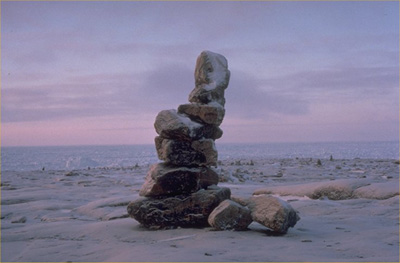Inuksuk National Historic Site of Canada
Enukso Point, Nunavut

View of single Inuksuit
© Parks Canada Agency / Agence Parcs Canada, 1989
Address :
Enukso Point, Nunavut
Recognition Statute:
Historic Sites and Monuments Act (R.S.C., 1985, c. H-4)
Designation Date:
1969-10-23
Event, Person, Organization:
Other Name(s):
-
Inuksuk
(Designation Name)
-
Inukshuks, Inukshuk
(Other Name)
Research Report Number:
1969-060, 2010-CED-SDC-017
Plaque(s)
Existing plaque: Enukso Point, Nunavut
Inuksuk, likenesses of men, are found all across the Canadian Arctic. Built by the Inuit, they served, depending on their size and location, as landmarks, memorials, kayak stands, meat platforms, pillars supporting drying lines, or elements of caribou fences. At Enukso Point, these cairns, totalling about 100, vary from a single stone set vertically to complex monuments up to seven feet high, and lie in two groups 150 metres apart. They are one expression of the ingenuity and artistry of the Inuit in making use of the resources of their environment.
Description of Historic Place
Inuksuk National Historic Site of Canada is situated on the Foxe Peninsula, approximately 88.5 km from Cape Dorset on the Southwest of Baffin Island, Nunavut. Set on the shore of the Northwestern Passages the site is situated above the high-tide line of the western and eastern sides of Enukso Point. The inuksuit, stone cairns, stand on the headland, a treeless, rocky hill sloping towards the sea. Two groups of Inuksuit exist on this site, approximately 100 of which remain standing. The two groups are set 465 feet apart and the southern cluster is 200 feet across. The Inuksuit consist of carefully piled stones placed to form cairns that can be complex, as large as 6 to 7 feet in height, sometimes figure-like, while smaller inuksuit may be composed of two balanced stones or single standing stones. The grouping of cairns may have been built as long as two thousand years ago. Official site recognition refers to a polygon on Foxe Penninsula, Baffin Island.
Heritage Value
Inuksuk was designated as a national historic site in 1969 because:
the Inuksuit, likenesses of men, are found across the Canadian Arctic, including about 100 at Enukso
Point and are one expression of the ingenuity and artistry of the Inuit.
The heritage value of Inuksuk derives from its scientific, social and spiritual importance. Inuksuk is a word that translates as “likenesses of men.” Collectively known as Inuksuit, the cairns are composed of carefully placed and selected stones. These constructions are found across the north individually and in groups. They are purposely created and depending on size and location may fill a variety of roles including landmarks situated on hilltops, cache markers for meat, memorials, kayak stands, pillars supporting drying lines, or elements of caribou fences, as well as ceremonial or spiritual roles. Their composition can vary from a single vertically set stone to complex monuments, some of which at this site reach 7 feet in height. This site contains nearly 100 cairns. The Inuksuit provide a testament to the hard-labour and creativity of the Inuit people who inhabited the North and were able to make use of the resources of their environment in an ingenious and artistic manner.
Character-Defining Elements
The key elements that relate to the heritage value of Inuksuk are: - the location at Enukso Point on Foxe Peninsula on the southwest side of Baffin Island, in Nunavut; - the setting on a treeless, rocky hill on a coastal peninsula; - the form of the cairns which varies from single vertically standing stones to complex monuments reaching up to seven feet in height; - the style, scale and materials of the approximately 100 stone inuksuit that are in two groups about 450 feet apart; - the method of construction and craftsmanship which provides a testament to the hard-labour and creativity of the Inuit people who inhabited the North and were able to make use of the resources of their environment in an ingenious and artistic manner; - integrity of any surviving or as yet unidentified archaeological remains which may be found within the site in their original placement and extent; - the situation and context of the Inuksuit as part of a larger tradition of the construction of cairns in the region of Northern Canada; -the inuksuit’s place as a representation of the art and the lives of First Nations people who have inhabited the North for thousands of years, with a variety of possible uses that include landmarks, memorials, kayak stands, meat platforms, pillars supporting drying lines, or elements of caribou fences; -viewscapes to and from the site.